“Perderò le classifiche di Google se sposto il mio blog?”. È la domanda numero uno che sentiamo ogni volta che chi siamo sta pensando di passare da Blogger a WordPress.
Lo capiamo, ma dopo aver aiutato innumerevoli blogger a compiere questa transizione, possiamo dirvi con sicurezza che è assolutamente possibile passare da Blogger a WordPress senza sacrificare il vostro posizionamento su Google.
Nel corso degli anni, abbiamo perfezionato il processo di migrazione per proteggere la vostra SEO mentre passate a una piattaforma di blog più potente. Attraverso prove ed errori, abbiamo scoperto esattamente cosa fare (e cosa evitare!) per proteggere il posto guadagnato con fatica nei risultati della ricerca di Google.
In questa guida vi illustreremo il nostro metodo collaudato per passare da Blogger a WordPress. Imparerete le stesse tecniche che abbiamo usato per aiutare innumerevoli blogger come voi a migliorare i loro siti senza sacrificare la loro visibilità nei motori di ricerca.
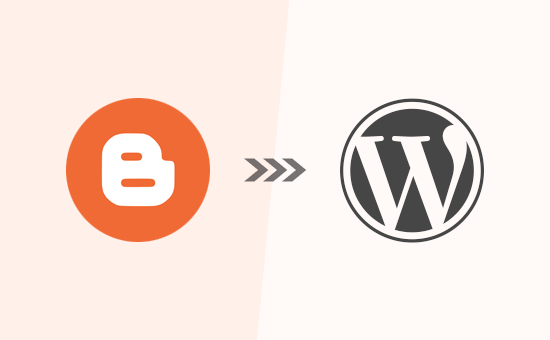
Perché passare da Blogger a WordPress?
Attualmente state usando Blogger, una popolare piattaforma di blog creata da Google che permette a chiunque di aprire un blog gratuito con il proprio account Google.
È un ottimo punto di partenza per molti, ma molti principianti si rendono subito conto che il loro blog gratuito su Blogger può sembrare un po’ limitato. Potreste ritrovarvi a desiderare di poter fare di più.
È qui che entra in gioco WordPress. A differenza di Blogger, WordPress.org vi dà il controllo completo del vostro sito web. Inoltre, vi permette di aggiungere le caratteristiche necessarie per far crescere il vostro blog e guadagnare online. E quando si tratta di farsi notare su Google, WordPress.org vi permette di effettuare tutte le modifiche SEO importanti per migliorare le vostre classifiche.
🌟 Volete maggiori informazioni? Abbiamo messo insieme un confronto dettagliato tra WordPress e Blogger, in modo che possiate vedere tutte le differenze.
Secondo le nostre statistiche di ricerca, WordPress è la piattaforma per siti web più diffusa al mondo e alimenta quasi il 43% di tutti i siti web.
Ciò significa che quando scegliete WordPress, vi unite a milioni di altri siti web di successo. Scegliete una piattaforma che gode della fiducia di moltissime persone e che è perfetta per mostrare i vostri contenuti.
Detto questo, esistono due tipi di software WordPress, per cui importa scegliere quello giusto.
Il primo è WordPress.com, che è un builder per siti web ospitati. Con WordPress.com, non è necessario trovare un piano di hosting e installare il software da soli. Potete invece scegliere un piano gratuito o acquistare uno dei piani a pagamento disponibili e Automattic ospiterà il vostro sito web per voi.
Poi c’è WordPress.org, noto anche come WordPress ospitato all’esterno. Consigliamo sempre di utilizzare WordPress.org perché, a differenza di WordPress.com, non è necessario pagare un piano costoso per poter installare i plugin (considerateli come degli add-on per il vostro nuovo sito web WordPress!).
Detto questo, vediamo come passare correttamente da Blogger a WordPress preservando le classifiche di ricerca su Google e il traffico del sito web.
Ecco tutti i passaggi che andremo a coprire per rendere il passaggio da Blogger a WordPress agevole e orientato alla SEO:
- Step 1. Sign up for WordPress Hosting
- Step 2. Export Your Blogger Blog
- Step 3. Import Blogger to WordPress
- Step 4. Setting Up Permalinks
- Step 5. Set Up Redirects From Blogger to WordPress
- Step 6. Moving Other Content From Blogger to WordPress
- Step 7. Things to Do After Migrating From Blogger to WordPress
- Video Tutorial
Pronti? Iniziamo.
Fase 1: Registrazione per l’hosting WordPress
Per iniziare a utilizzare WordPress, è necessario disporre di un nome di dominio e di un hosting web.
Per un rapido promemoria, il nome di dominio è l’indirizzo del vostro sito web che le persone digitano per raggiungere il vostro blog, mentre l’hosting web è il luogo in cui vengono memorizzati i file del vostro sito. Entrambi sono indispensabili per creare qualsiasi tipo di blog o sito web.
Detto questo, vi consigliamo di utilizzare Bluehost. Si tratta di una delle più grandi società di hosting al mondo e di un partner di hosting WordPress ufficialmente raccomandato.
Poiché WPBeginner è il più grande sito di risorse per WordPress, ha accettato di offrire ai nostri lettori un dominio gratuito e uno sconto del 60% sull’host. In pratica, potete iniziare a lavorare per soli 1,99 dollari al mese.
Se preferite un’alternativa a Bluehost, vi consigliamo di utilizzare SiteGround o Hostinger, perché sono entrambe soluzioni eccellenti (in effetti, noi utilizziamo SiteGround per ospitare WPBeginner!).
Una volta sottoscritto il piano di hosting WordPress e impostato il dominio, si può procedere alla fase di installazione di WordPress.
Se vi iscrivete a Bluehost utilizzando il nostro link qui sopra, vi installerà automaticamente WordPress.
Se avete utilizzato un altro provider di hosting WordPress, allora dovete installare WordPress seguendo la nostra guida definitiva su come installare WordPress.
Dopo aver installato WordPress, è il momento di spostare i contenuti da Blogger a WordPress.
🧑💻 Vi abbiamo sentito forte e cancellato! Poiché molti di voi ce lo hanno chiesto, siamo entusiasti di annunciare che ora offriamo un servizio di migrazione da Blogger a WordPress completamente gratuito come parte della configurazione gratuita del nostro blog WordPress! Proprio così: uno dei membri del nostro team di esperti si occuperà di tutto per voi, gratuitamente. Potrete letteralmente passare da Blogger al potente mondo di WordPress senza alcun problema o rischio.
Il nostro servizio gratuito di migrazione da Blogger è perfetto per i blog più piccoli, con meno di 1000 pubblicazioni. Se avete un sito Blogger più grande, non preoccupatevi! Possiamo comunque aiutarvi con la migrazione, ma si tratta di un servizio a pagamento.
Passo 1: Esportare il blog di Blogger
La prima cosa da fare è esportare i contenuti del blog Blogger. Per farlo, visitate il sito web di Blogger e accedete al cruscotto del vostro account.
Successivamente, andare alla pagina delle impostazioni. Scorrere fino alla sezione “Gestione del blog” e fare clic sul pulsante “Backup dei contenuti”.
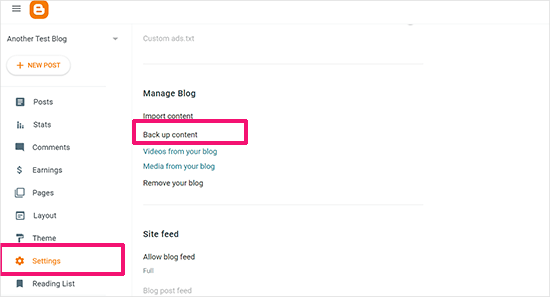
Verrà visualizzata una finestra a comparsa che mostra cosa è esattamente incluso nel backup di Blogger.
Per continuare è necessario fare clic sul pulsante “Download”.
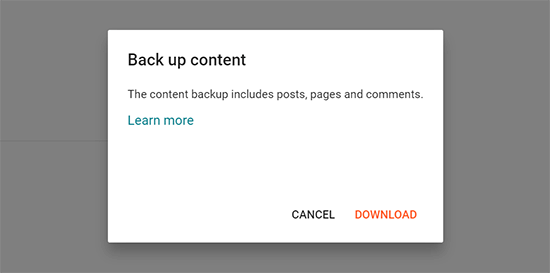
Il contenuto del vostro blog Blogger verrà scaricato sul vostro computer in un file XML.
Una volta completato il download, è il momento di importare i contenuti di Blogger nel sito WordPress.
Passo 2: Importare Blogger in WordPress
Per iniziare a importare il vostro sito Blogger in WordPress, accedete all’area di amministrazione di WordPress e visitate Strumenti ” Importazione.
Nella pagina di importazione, fare clic sul link “Installa ora” sotto Blogger.
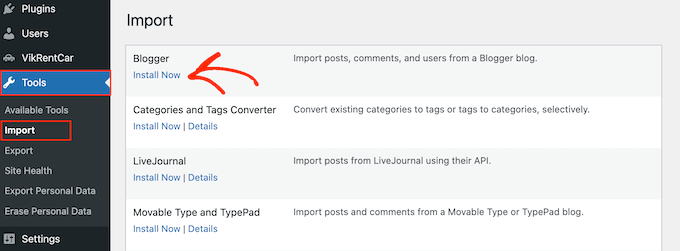
WordPress scaricherà e installerà il plugin Blogger Importer per voi.
Una volta terminata l’installazione, è necessario fare clic sul link “Run Importer” per continuare.
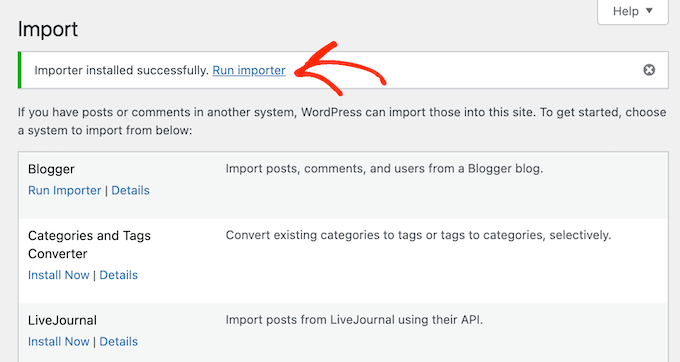
WordPress vi chiederà di caricare il file XML nella schermata Importa Blogger. Si tratta del file scaricato al punto 1.
È sufficiente fare clic sul pulsante “Scegli file” e caricare il file XML scaricato in precedenza.
Quindi, fare clic sul pulsante “Carica file e importa” per continuare.
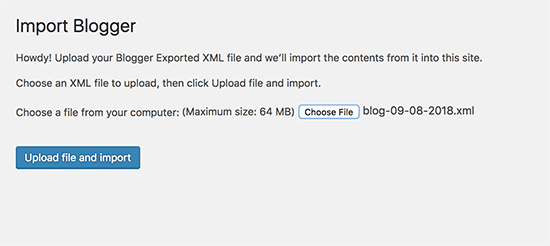
WordPress caricherà ora il file di importazione. Se il file di importazione è troppo grande, potrebbe essere visualizzato un messaggio di errore.
In questo caso, è necessario aumentare il limite massimo di caricamento dei file. Se il file è di piccole dimensioni, non si noterà alcun errore.
Successivamente, vi verrà chiesto di assegnare i post a un autore. Se avete più autori sul vostro blog Blogger, potete creare un nuovo account utente per ogni autore. Potete anche assegnare questi post ad autori esistenti sul vostro sito WordPress.
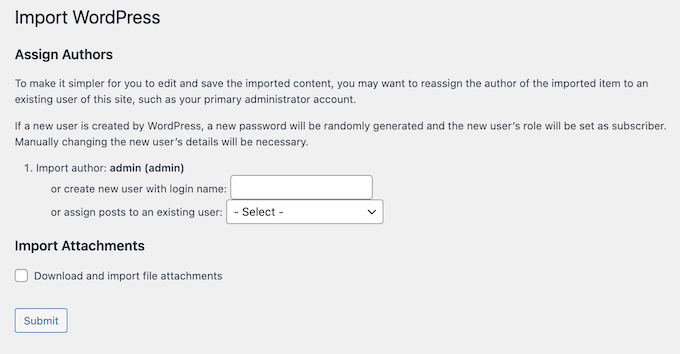
Dopo aver effettuato la selezione, fare clic sul pulsante “Invia” per continuare.
WordPress importerà tutti i contenuti dal file di esportazione di Blogger al vostro sito WordPress. È possibile visualizzare il contenuto visitando la pagina Post ” Tutti i post.
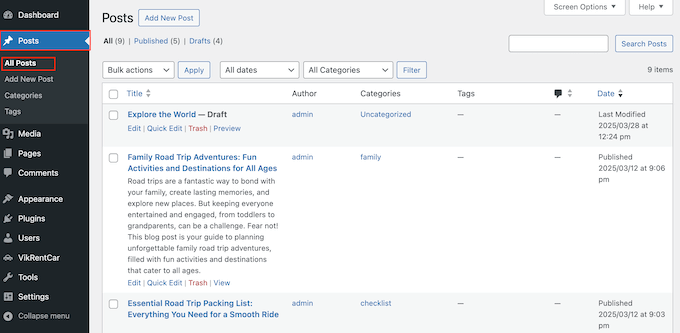
Passo 3: Impostazione dei permalink
Permalinks è il termine usato per la struttura degli URL delle singole pagine. WordPress è dotato di una funzione che consente di impostare una struttura URL SEO-friendly.
Poiché state importando contenuti da Blogger, è necessario che la struttura degli URL sia il più possibile simile a quella del vecchio sito di Blogger.
Per impostare i permalink, è necessario andare su Impostazioni ” Permalink nella dashboard di WordPress e scegliere l’opzione “Struttura personalizzata”.
Successivamente, è necessario aggiungere il seguente testo nella casella accanto al campo della struttura personalizzata:
1 | /%year%/%monthnum%/%postname%.html |
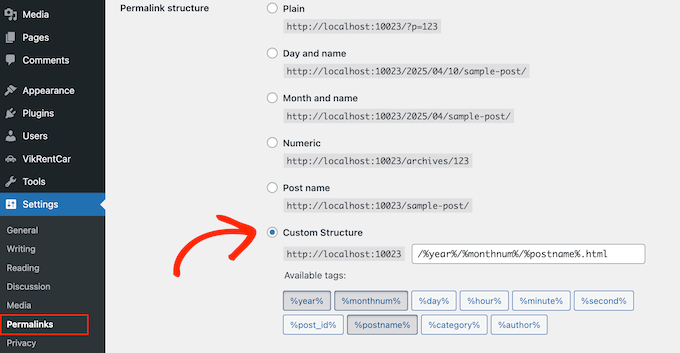
Questa struttura di permalink rende gli URL dei post del blog simili a quelli del vecchio blog di Blogger.
Tuttavia, a volte l’URL del post del blog, noto anche come slug in WordPress, non corrisponde agli slug utilizzati da Blogger.
Per risolvere questo problema, è necessario creare ed eseguire un piccolo frammento di codice.
Si consiglia di aggiungere questo codice PHP utilizzando il plugin WPCode. È il modo più sicuro per aggiungere codice personalizzato al vostro sito WordPress. Per maggiori dettagli, consultate la nostra guida su come copiare e incollare snippet di codice in WordPress.
1 2 3 4 5 6 7 8 9 10 11 12 13 14 | add_action( 'init', 'wpb_update_slug' );function wpb_update_slug() {global $wpdb;$result = $wpdb->get_results("SELECT post_id, meta_value FROM $wpdb->postmeta WHERE meta_key = 'blogger_permalink' ");$wpdb->print_error();foreach ($result as $row){$slug = explode("/",$row->meta_value);$slug = explode(".",$slug[3]);$wpdb->query("UPDATE $wpdb->posts SET post_name ='$slug[0]' WHERE ID = '$row->post_id' ");}echo "DONE";} |
Dopo aver salvato il codice, è sufficiente visitare una pagina qualsiasi del vostro sito WordPress per triggerare lo script. Dopo l’esecuzione dello script, non dimenticate di disabilitarlo o eliminarlo dalla libreria WPCode, perché deve essere eseguito solo una volta.
Passo 4: Impostare i reindirizzamenti da Blogger a WordPress
Il passo più importante nel trasferimento di un sito web è quello di impostare una corretta reindirizzazione, in modo da non perdere il traffico esistente o le classifiche SEO. Per maggiori dettagli, potete consultare la nostra lista di controllo definitiva per la migrazione SEO di WordPress.
⚠️ Se il vostro blog Blogger ha un dominio personalizzato invece di blogspot.com, potrebbe essere necessario puntare i nameserver del dominio al vostro fornitore di hosting. Per istruzioni, seguite il nostro tutorial su come passare un blog Blogger con dominio personalizzato a WordPress.
La parte cruciale del reindirizzamento consiste nel garantire che gli utenti arrivino sulla stessa pagina del nuovo dominio a cui stavano cercando di accedere sul vecchio sito.
Allo stesso tempo, dovete anche assicurarvi che i motori di ricerca capiscano che il vostro sito web è stato spostato in questa nuova posizione.
Per farlo, è necessario installare e attivare il plugin Blogger to WordPress Redirection. Per maggiori dettagli, consultate la nostra guida passo passo su come installare un plugin per WordPress.
Dopo l’attivazione, è necessario visitare la pagina Strumenti ” Reindirizzamento da Blogger a WordPress e fare clic sul pulsante “Avvia configurazione”.
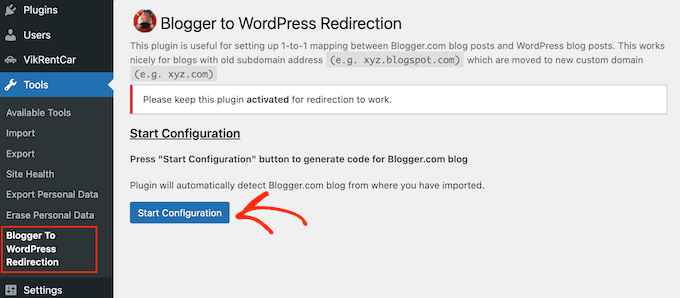
Il plugin rileverà ora l’URL del vostro blog Blogger e vi mostrerà l’opzione per ottenere un codice di reindirizzamento. Fare clic sul pulsante “Ottieni codice” accanto all’URL di Blogger.
A questo punto verrà generato uno snippet di codice necessario per reindirizzare correttamente gli utenti dal vecchio blog Blogger al nuovo sito WordPress.
Successivamente, è necessario accedere alla dashboard di Blogger e andare alla pagina “Temi”. Fate clic sulla freccia a discesa del pulsante “Personalizza” accanto al vostro tema e selezionate l’opzione “Modifica HTML”.
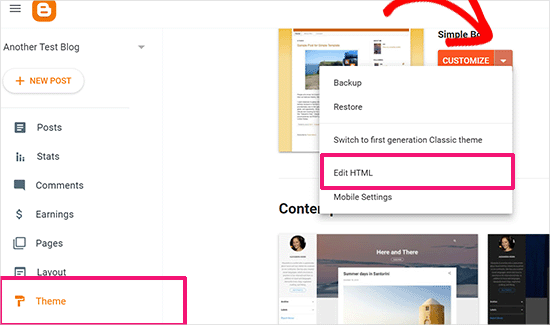
Blogger visualizzerà ora il codice HTML personalizzato per il modello del tema. Se sono state apportate delle personalizzazioni al tema di Blogger, è consigliabile copiare il codice e salvarlo sul computer come backup.
In caso contrario, è possibile procedere all’eliminazione di tutto. Dopodiché, copiate il codice visualizzato dal plugin sul vostro sito WordPress e incollatelo nell’editor del tema di Blogger.
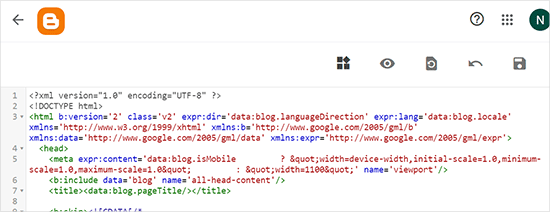
Non dimenticate di fare clic sul pulsante “Salva tema” per memorizzare le modifiche.
Successivamente, dobbiamo impostare i reindirizzamenti per gli utenti mobili.
È necessario tornare alla pagina dei temi nella dashboard del blog Blogger. Questa volta dovete fare clic sul pulsante dell’ingranaggio sotto l’anteprima mobile del vostro blog.
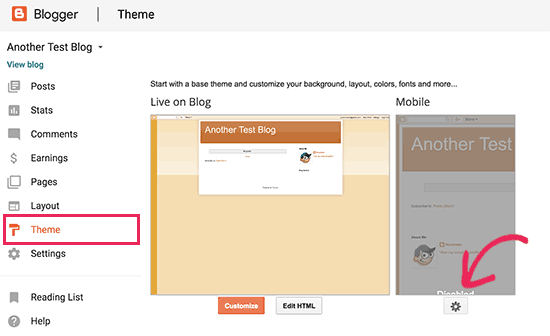
Si aprirà un popup in cui si dovrà selezionare l’opzione “No. Mostra il tema desktop sui dispositivi mobili”.
Quindi, fare clic sul pulsante “Salva”.
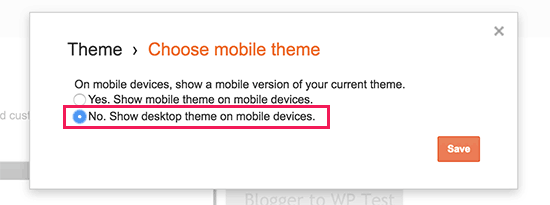
È tutto, il vostro blog Blogger ora reindirizzerà tutti i visitatori del blog al vostro nuovo blog WordPress.
In alternativa, è possibile utilizzare All in One SEO (AIOSEO) per reindirizzare post e pagine da Blogger a WordPress. Il plugin offre una potente funzione di gestione dei reindirizzamenti che consente di impostare reindirizzamenti completi al nuovo sito.

Inoltre, è possibile attivare il monitoraggio degli errori 404 e individuare eventuali link non funzionanti nel passaggio del sito a WordPress. In questo modo migliorerete l’esperienza dell’utente e non perderete il posizionamento delle parole chiave.
Utilizziamo AIOSEO per gestire tutte le pagine e le pubblicazioni di WPBeginner – e onestamente? I risultati ci hanno entusiasmato. Ecco perché lo consigliamo a tutti voi.
Per approfondire le nostre esperienze, consultate la nostra recensione dettagliata di AIOSEO.
Passo 5: Spostare altri contenuti da Blogger a WordPress
In questa fase, sposteremo i contenuti rimanenti dal vecchio blog su Blogger al nuovo blog WordPress. Questa operazione potrebbe richiedere un po’ di lavoro manuale, a seconda delle impostazioni/contenuti del vostro blog.
1. Spostare le pagine da Blogger a WordPress
Lo strumento di importazione di Blogger di WordPress importa solo i post di Blogger e ignora le pagine.
Per trasferire le vostre pagine in WordPress, dovrete modificare ogni pagina del vostro blog Blogger, copiarne il contenuto e poi creare manualmente una pagina in WordPress.
Per saperne di più sulle pagine, consultate il nostro articolo sulla differenza tra post e pagine in WordPress.
Ora vi imbatterete in un altro problema. Le pagine di Blogger hanno URL di questo tipo:
http://example.blogspot.com/p/about-us.html
L’URL della pagina di WordPress avrà il seguente aspetto:
http://example.com/about-us
Per risolvere questo problema, è necessario utilizzare il plugin All in One SEO (AIOSEO). Per le istruzioni, consultare la nostra guida per principianti sulla creazione di redirect in WordPress.
2. I widget
Come Blogger, anche alcuni temi di WordPress utilizzano i widget per aggiungere contenuti alla barra laterale del blog.
Per aggiungere i widget, è necessario visitare la pagina Aspetto ” Widget nella dashboard di WordPress e trascinare semplicemente i widget nelle barre laterali. Per istruzioni dettagliate, consultate la nostra guida su come aggiungere e utilizzare i widget in WordPress.
Se state cercando un widget specifico che non è presente in WordPress per impostazione predefinita, probabilmente avete bisogno di un plugin per WordPress. Potete cercare nella categoria dei migliori plugin per WordPress di WPBeginner per trovare la funzionalità che desiderate.
3. Feed RSS
I motori di ricerca e gli utenti che si iscrivono ai post del vostro blog tramite feed RSS saranno ancora in grado di trovare il vostro blog. Tuttavia, non riceveranno alcun nuovo contenuto.
Per risolvere il problema, visitate la pagina delle impostazioni del vostro account Blogger. Scorrete quindi la sezione “Feed del sito” e fate clic su “URL di reindirizzamento del feed del post”.
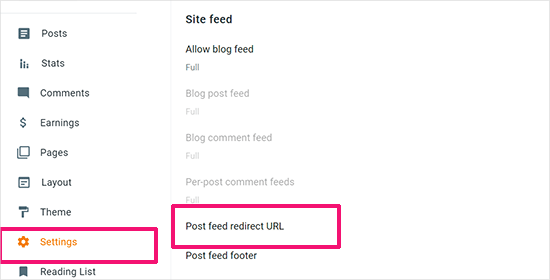
Si aprirà una finestra a comparsa in cui dovrete aggiungere l’URL del feed RSS del vostro sito web WordPress.
L’URL del feed di WordPress avrà il seguente aspetto:
http://example.com/feed
Non dimenticate di sostituire example.com con il vostro nome di dominio.
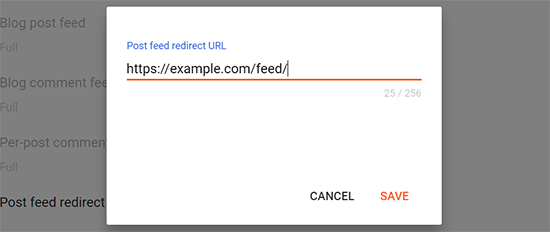
Fare clic sul pulsante “Salva” per aggiungere l’URL e salvare le impostazioni.
Passo 6. Cose da fare dopo la migrazione da Blogger a WordPress
Ora che avete trasferito con successo il vostro blog da Blogger a WordPress, vediamo cos’altro potete fare per migliorare il vostro blog.
Abbiamo creato una lista di controllo delle cose più importanti da fare dopo l’installazione di WordPress.
WordPress è abbastanza facile da usare. Tuttavia, di tanto in tanto scoprirete cose nuove per le quali potreste aver bisogno di aiuto. È qui che entra in gioco WPBeginner.
WPBeginner è il più grande sito di risorse gratuite per WordPress al mondo. Pubblichiamo regolarmente tutorial e guide scritte appositamente per blogger e piccole imprese.
Ecco alcune delle risorse utili che troverete su WPBeginner (tutte gratuite):
- WPBeginner Blog – Il luogo centrale per tutti i nostri tutorial e guide su WordPress.
- Dizionario WPBeginner – Il nostro glossario di WordPress è il posto migliore per familiarizzare con il gergo di WordPress.
- Video WPBeginner – I nuovi utenti di WordPress possono iniziare con questi video passo-passo per padroneggiare WordPress.
- WPBeginner su YouTube – Avete bisogno di altre istruzioni video? Iscrivetevi al nostro canale YouTube con più di 291.000 iscritti e oltre 50 milioni di visualizzazioni.
- WPBeginner Blueprint – Scopri i plugin, gli strumenti e i servizi che utilizziamo su WPBeginner.
- WPBeginner Deals – Sconti esclusivi su prodotti e servizi WordPress per gli utenti WPBeginner.
Video tutorial
Speriamo che questo articolo vi abbia aiutato a passare da Blogger a WordPress senza influenzare le vostre posizioni di ricerca su Google. Potreste anche voler consultare la nostra guida su quale piano WordPress dovreste utilizzare o i più comuni miti di WordPress sfatati.
Se questo articolo vi è piaciuto, iscrivetevi al nostro canale YouTube per le esercitazioni video su WordPress. Potete trovarci anche su Twitter e Facebook.





Marco Dickert
Hi there,
I just tried to migrate my blogger-blog to my self-hosted wordpress. Almost all things work as expected, but not the redirection from blogger. I inserted a logging function in the template code for the wordpress-sided interface and recognized that this page does not get any parameters from the blogger redirection. That means I simply get redirected to my home page.
Is it possible that blogger changed variable names or something? Does anyone has an idea how I could fix that problem?
Cheers, Marco
WPBeginner Support
Marco, we have just updated the post with a completely new re-written version. Please follow it now, hopefully it will resolve your issue.
Admin
Marco Dickert
@WPBEGINNER Support:
First of all: It’s really nice that you’ve updated this article! I guess you help many users with that.
Meanwhile I solved my problem, and wrote my solution in an email to Amit Agarwal, but he seems to be very busy.
Since I come from Germany I don’t get “blogspot.com”-Domains in my Google search results, but “blogspot.de”. Others in German-speaking Europe get also different TLDs like “blogspot.at” or “blogspot.ch”. That is a problem for the template code. I could fix that simply by changing these lines:
$tld_fix = preg_replace("/blogspot\.[a-zA-Z0-9]+/", "blogspot.com", $old_url);$permalink = explode("blogspot.com", $tld_fix);With this fix it should work all around the world. Maybe you can implement it in your post; it might be useful for some people.
Cheers, Marco
WPBeginner Support
Thanks Marco for this really useful fix. We have updated the article to include this.
nil
Hey,
I have the same problem. Tried your script but when I go to an old posting I just get redirected to my first page, not to the post.
Regards
nil
Liza Pritz
Wouldn’t it be easier to use a plugin? Something like “CMS2CMS Blogger to WordPress Converter” ? With this plugin, it is posible to migreta the content, the set up 301 redirect and keep all the visitors and ranking on a new WordPress site?
Does anyone knows something about that?
Saad Ansari
Nice efforts. One shop stop guide for Blogger to WordPress migration.
Is there any way of importing all images from blogger and put them all together in WordPress? I’ve a huge number of images with me. Uploading each of them MANUALLY would be a nightmare, isn’t it? So do let me know if there is any smart and efficient plan B for it. Thanks!
Xuhair Raxa
great post !!! but i have a question.. that is after the conversion,will the domain be .com or blogspot.com ? As i have a blog http://tricksnsolutions.com which is wp blog after making it a blogger blog shall it remain to tricksnsolutions.com or tricksnsolutions.blogspot.com ? please solve my confusion
WPBeginner Support
This guide is for switching from Blogger to WordPress not the other way around.
Admin
Briana M
My old website is with Blogger, but I am switching over to WordPress and using a new domain name. I already have hundreds of business cards with my old domain name listed (###.blogspot.com) and I want that old domain name through Blogger to redirect to my new domain name and WordPress website. How can I go about doing this?
WPBeginner Support
You can do so following the steps mentioned in the article above.
Admin
Kanchana
thanks ,,,
Bryan
Hi there,
I am a newbie.
I just wanted to ask a quick question:
When I import my blogger posts into wordpress, will they be deleted from blogger or will they still be there with no changes?
Thanks
WPBeginner Support
They will still be there if you don’t explicitly delete them.
Admin
Christian
Hi!
The Blogger code doesn’t work today. I think the markup is obsolete because Blogger says the following by submitting the code from WP Beginner:
“The value of attribute “dir” associated with an element type “html” must not contain the ‘<' character."
I just replaced simple and double quotes and other ways to solve this, but is completely impossible. Does anyone know if Blogger has made related to the markup?
Thank you all.
hafzaa
Very well explained…will try it..hope so it may work…
Kapil Dev Singh
I have moved from blogger to WordPress and carried out all the steps. I am encountering two problems-
1. The blogger link for specific blogs is not taking me to the wordpress
2. When someone wants to come to wordpress following a specific blog link, it shows – the file could not be found and give a list of all the published blogs. Once clicked on the specific blog for which the link was followed, it opens up.
Regards
Desi
I keep getting this message in blogger
Error parsing XML, line 2, column 73: The value of attribute “dir” associated with an element type “html” must not contain the ‘<' character.
anyone else?
Carl
(Previous comment did not include code… how can I do that?)
Not sure if something has fundamentally changed with the blogger importer or how posts info is stored in the database; But the code above for the wpbeginner-blogger.php failed for almost all my links. I ended up changing it to this:
<?php/*Template Name: Blogger Redirect (do not use)*/global $wpdb;$old_url = $_GET['q'];if ($old_url != "") {$permalink = explode("blogspot.com.au", $old_url);$new_url = $permalink[1];header ("HTTP/1.1 301 Moved Permanently");header("Location: $new_url");}?>Anyone see any reason this is bad? It seems to work perfectly, I’m still trying to figure out why it was done any other way to begin with… As long as you fix the permalinks to match the old blogger ones
Dean
Hi, hopefully someone will be able to help. Whenever I click one of my old blogger posts it just sends me to my new wordpress site’s homepage not to the correct blog post? any ideas how to fix this. thanks.
Raj Amal
My old blogger posts it just sends me to my new wordpress site’s homepage not to the correct blog post. Plese help me
Paige
I’m having the same issues. How did you fix this?
Sanskar
I am stuck with the infinite loop. The website keeps refreshing and never loads. I am not sure how to fix it.
Sanskar
OK, I am sorry about the previous comment. I was using Switch hosts firefox plugin and I was browsing on my local copy. My website has not gone live yet. Though I have clicked on Go live button on Godaddy, and looks like DNS settings are updated, but my website has gone in an infinite loop and never loads. It loads the title, loads the favicon and I also see it loading chrome extensions like alexa and adblock, but then it refreshes and starts loading again. This never stops.
Do you think it is the problem with DNS? or that I did not follow the tutorial properly? It has been already 11 hours since I updated the DNS. Both my domain and hosting is bought from Godaddy.
WPBeginner Support
Using an FTP client, connect to your website and download .htaccess file to your computer. Then delete the one on your live site. See if this resolves the issue. If it does, then this means there is nothing wrong with DNS settings of your website and it was probably a redirection issue. You may also contact your web host for support if this does not solve your issue.
Admin
Gari Anne
Everything worked perfectly! Thanks! How Long do I have to leave the Published “Blogger” page on my new word press blog? Or is there a way to hide that page?
Carol
I’m still having the same problems but none of my comments have been published or answered. Did the guy who wrote this post give up on it? I’ve noticed a few people had the same problem – is it something that can be fixed? It would be great to get a response.
Thanks
carol
ok – I’ve been reuploading the text doc over and over and one thing that has changed is – I’m using a Mac and my doc is .rtf. When I take the .rtf off after the .php I get the line 16 error code but if I keep the.rtf on after the .php and I clink on any of my blogger posts it redirects to the Blogger page that I created for the redirect on my new website. Does that make sense? I don’t understand any of this php stuff so I don’t have any idea why it would do that just by adding or deleting the .rtf extension – but that’s what happens.
I hope you have some idea of how I can fix this. It seems like it’s something pretty simple – I just don’t know what.
carol
i just redid all the the cpanel installation part and now the syntax error says line 16
Parse error: syntax error, unexpected T_STRING in /home4/craftyc/public_html/wp-content/themes/suffusion/wpbeginner-blogger.php on line 16
carol
I just went through the whole process and when I click on “View Blog” on my Blogger page it redirects perfectly to my website (yay!), but if I click on any of the individual posts I get this error message:
Parse error: syntax error, unexpected T_STRING in /home4/craftyc/public_html/wp-content/themes/suffusion/wpbeginner-blogger.php on line 15
I saw some people here getting syntax errors on different lines but I didn’t see anything to fix it.
Besplatne Knjige
Hello!
I have this blogger blog, and I would like to build some backlinks on worpress blog. Is there any way to create some wordpress blog and automatically post parts of my original post from blogger with my link. Something like auto post on social networks…
I hope you understand what I want (my English is not so good)
Thank you
nick
hi, i am about to carry out this process but i have one concern. my blogger address doesnt have the blogspot.com attached to it. i paid to have the domain showing just my blog name. however i still edit my blog with blogger. now i want to switch and im wondering if theres any step i need to do differently so as not to run into problems.
cheers
Sharon
I have the same situation. I already bought my domain but still hosting it on blogger and I want to switch but I don’t know if I should follow the same steps as discussed here on this post. Any help is greatly appreciated.
Jackie Montalvo
I have the same issue so I’d love to hear what my options are because I’ve wanted to switch ove but I wasn’t sure I could since I bought the domain name already. Please let me know!
WPBeginner Support
You can manage your custom domain from the registrar website. Currently Blogger has stopped offering custom domain registration from the Blogger interface so most users need to purchase a domain from another registrar and then setup the domain to point to the Google servers. When moving this domain to a new web host you need to remove these settings from your domain control panel on the registrar’s website.
1. First find out your domain registrar.
2. Login to your domain registrar control panel.
3. Remove CNAME and A record settings pointing to Google servers.
4. Enter your new webhost’s settings into domain control panel.
Most WordPress hosting providers offer detailed guides on how to move a domain name to point to their servers.
Admin
Holt Johnson
I found the Blogger To WordPress plugin to be much simpler to use.
http://wordpress.org/plugins/blogger-to-wordpress-redirection/
Amanda
Thank you SO much for posting that plugin …. I was going crazy trying different tutorials with none of them working!
Naomi Madelin
I tried this, but get the message from WordPress that I can’t access Content nor fiddle with Themes in any way. So I’m now stuck!
Sagar
Hello!
I want to migrate a blog on Blogger to WordPress which just has 15 pages, no posts, so I can do it manually, but I want to know about 301 redirect, how do I do it? Please can you help me with this?
Elaine Griffin
I’m very confused, because when I go to tools -> import, I am prompted to download a plugin. Any thoughts?
Thanks!
Editorial Staff
Yes you have to do that.
Admin
Emma
Does anyone know if you can import from 2 different blogger blogs into one wp?
Jan Bear
Thanks for a useful post.
When you’ve finished this process, will you be able to do future blog posts in WordPress, or do you have to continue using Blogger as your blog platform?
Does this integrate the WordPress and Blogger blog posts? Or will they be on separate pages of the new site?
Editorial Staff
You would have to use WordPress for all new posts.
Admin
Wendi Gratz
Never mind – I figured it out. For those who run into the same problem. . .
When you copy and paste the PHP coding make sure there isn’t a blank line above the start of the <?php.
I don't know if mine snuck in during copying or pasting – but I removed it and everything works perfectly now.
Lenin
For some users, all the blogspot posts might be redirected to the new blog homepage (and not the individual new post URL). This is because the original link is blogspot.in and not blogspot.com
To fix this issue, add the following line of code after the link $permalink = explode(“blogspot.com”, $old_url);
if(count($permalink) == 1) //we cant find blogspot.com in the URL lets try for blogspot.in
{
$permalink = explode(“blogspot.in”, $old_url);
}
Tim
Great post. Unfortunately after doing this Google marked my old Blogger blog as a spam blog! I’m going through the process to get it unlocked, so hopefully that will solve it. Great tutorial though and very simple to follow – thanks!
John Pile
This is a really great step-by-step tutorial. Unfortunately, I missed one of the wpbeginner.com links in the replacement template for my blogger site. It resulted in redirecting to your website, which then prompted Blogger to immediately mark my blog as SPAM.
I fixed the template and now everything redirects correctly, but I had to request that my blog be reviewed or else it will be deleted in 22 days.
I’m wondering if anyone else has ran into this issue and how the review process went? I used one of my test websites for this, so I won’t be incredibly disappointed if the original blogger site is deleted, but I did want to offer this warning to others. I recommend using CTRL-F to replace all occurrences of wpbeginner.com in the template.
-John
Tim
I replaced all instances and it still marked my old blog as spam. It must just be the fact that it’s doing a complete redirect that makes them think it could be spam. I’ve just kicked off the review process, so I’ll have to see how it goes. Did yours come back ok in the end?
R. endymion
Hello, I’ve also replaced all instances but it is still marked as SPAM. Has anybody found a solution for this ?
Thank you.
R. endymion
I report to google and they change it in only one day. We just need to be patient.
jose morales
I just downloaded all my site in Blogger however it is not showing the whole article… any ideas?
Salue
i’v done all of this THANK YOU
was wondering 1 thing can i delete the blogger page that i made ? because its showing in the menu bar like next to about me
zed kosnar
Hello again! managed to fix the other error, and now i get redirected from Blogger to wordpress, but if I click on an old post, of blogger I get his message “Parse error: syntax error, unexpected T_LNUMBER in /nfs/c09/h01/mnt/127155/domains/desdeabajo.net/html/wp-content/themes/twentyeleven/WPBeginner-Blogger.php on line 5” hope you can guide me here… Thanx in advance!
zed kosnar
Hello!
I followed the instructions but when I posted the HTML (step 5) try to check “a preview” I get this message “Your template could not be parsed as it is not well-formed. Please make sure all XML elements are closed properly. XML error message: Comment must start with “<!–".
Error 500 " I double checked data and still getting this message, doesn't save if I click try to go ahead… Any thoughts what I could be doing wrong? Thank you!
David
Hi, on step 5 I get this message:
Error parsing XML, line 3, column 73: The value of attribute “dir” associated with an element type “null” must not contain the ‘<' character.
Can you help?
nick
solve this issue? im experiencing the same error
Alexander
The problem occurs if you do not press “Revert to classic template”. Even if you did not changed the template at the beginning you have to revert to classic template, then it should work.
Joanna Mecina
Hello, i have a blogger template, how ca i convert it to wordpress? Thanks
Linda Leyble
Hi – very good post. I switched last month from Blogger and I am very happy. But, since Feedburner is going away – do you recommend that we use FeedBlitz instead? Very confused about this.
And also – when I left Blogger – I lost many of my followers on GoogleFriend Connect. I emailed my followers there and alerted them to my new site. Slowly but surely I am gaining them back on my new site. I also emailed the RSS followers on Feedburner and also on Bloglovin. Do you recommend any other ways for people to follow your blog?
Thanks,
Linda
Editorial Staff
We haven’t seen any public press release by Google that says FeedBurner is going away. Sure there are some speculations around the industry that it is, but only time will tell. We are sticking with feedburner for now.
Admin
Kaitlin
Everything looked great, but now that I’m clicking past links (posted to facebook) to check if the redirect is working properly, I’m getting this error:
Parse error: syntax error, unexpected T_STRING in /home/content/81/9774981/html/wp-content/themes/simple-catch/WPBeginner-Blogger.php on line 3
Help?
Editorial Staff
Line 3 is the name of the template. There has to be another error.
Admin
Jeanne
I just migrated a blog from blogger to WordPress but used a plugin to perform a similar task as above. I don’t like plugins and am thinking of deactivating it and doing this instead.
Question though: One thing I found that did NOT work when I did this was that pages did not redirect. Posts redirected just fine with no problems at all (well, I did have to have my hosting provider whitelist mod security) but PAGES would not redirect at all (and, worse, not only would they not redirect, links pointing to old blogger pages would return a “page not found” error).
Before I deactivate the plugin I’m using, and go this route, I’m curious if this will work for pages….Any comment?
Thanks!!
Gretchen Louise
I’m not seeing the “Revert to Classic Template” anywhere. Have they removed that option?
Dave Morrow
Agreed, I am having the same problem, the newest Blogger does not seem to have that option… Anyone else have an answer for this?
Tom G
Go to templates…
Scroll to the bottom of the page.
It says something like “Classic Template” or something like that. I can;t get to it now that I have done it.
Then scroll to the bottom of that refreshed page. It’s at the bottom.
Sorry if this doesn’t make sense. It was not as cut and dry as listed above.
Chetan
Nice Post. I was wondering if moving from blogspot to wordpress is possible if I have a custom domain hosted on blogger?
Look forward to your reply.
Monkey
Hi, Great tutorial thank you.
Does this work with any wordpress theme?
I am very new to WordPress. So apologies if this is an ignorant question.
Editorial Staff
Yes this should work with any WordPress theme.
Admin
Ahmad Awais
Nice tutorial Faizan Bro, Finally you are using WordPress
I hope you are not quite aware of the fact that WP is much strong than Blogger platform.
Keep up your great work.
–
I would rather say that instead of page template you can slowly move on to each post and use 301 redirect plugin for redirecting and making your blog independent of the old blogger’s template.
Syed Faizan Ali
Thanks Bro, Yeah After going through lots of Articles and Tutorials I discovered WordPress is the best Blogging Platform I have converted few of my Blogger Blog to The Self-Hosted WordPress Blog.
Your Idea is Cool but if we have tons of Posts like 4000 posts, then redirecting would become stressful. This method is quite good, takes less time and gives perfect results.
Derek
Hi Stephen,
For step 4 how do you write “blogger” in the URL? Click on change permalinks? I did that and change the permalink to end with /blogger but still revert back to previous URL that end with ?page_id=149.
Syed Faizan Ali
Brother Create a New Page and Write The Title blogger, Choose WPbeginner from the Template Menu don’t Worry About the URL And Publish it, Now Open the Published Page Again From Your WordPress ADMIN PANEL and you will be able to See the URL beneath the Page Title, Just Click EDIT and rename it to /blogger and don’t Forget to UPDATE THE POST.
Also Update your WordPress Permalink Go to WordPress Dashboard >> Settings >> Permalinks >> Custom Structure >> /%year%/%monthnum%/%postname%.html.
Gautam Doddamani
i was using blogger earlier but changed to wordpress since it is the best cms around and also i get full control over my site…and there are a ton of tutorials for wordpress which makes blogging more easier and fixing site less time consuming
Syed Faizan Ali
Yes, indeed WordPress has the most powerful Blogging Platform. Keep it up on Good Things Peace and Blessing.
Guppu Boss
Nice Tutorial Faizan. I have just purchased hosting and after my exams i am going to transfer my blogger blog to wordpress. You explained all steps very well. Will follow this tutorial again while transfering my blog.
Syed Faizan Ali
Thanks For Sharing Nice Views, Yes Brother Feel Free To Apply This Tutorial Any Time You Like. Its Great That you are thinking to move from Blogger to WordPress, it will give more power to you. Peace Mate
Mairaj Pirzada
Great Post, well done Syed Brother! You did a Nice Work! Keep it up but I don’t need this post as My site is now setup on WordPress!
Syed Faizan Ali
Oh it’s Splendid, that you are already using WordPress. Thanks Buddy. Peace and Blessings
Stephen Cronin
Hi. Have you tested that PageRank is preserved?
The 301 is happening on your WordPress site, not your Blogger site. It is merely telling Google to use one of your WordPress pages instead of another one of your WordPress pages (and transfer PageRank between these).
The 301 is not telling Google to use your WordPress site instead of your Blogger site, or to transfer any PageRank from your Blogger site to your WordPress one.
You’re using JavaScript to move *users* from the Blogger site to the WordPress one, but there is no evidence that Google will treat this as a 301 and transfer any pagerank.
A few years ago, the prevailing SEO wisdom would have been that Google couldn’t even crawl the JavaScript, so the Googlebot wouldn’t even go to the WordPress site. Googlebot can now execute some JavaScript, but still – what makes you think it will treat it as a 301?
I’m not having a go at you personally, but this is the first I’ve heard of this (I can’t find anyone else in SEO circlet talking about this) and I’d be really interested in seeing the evidence that this works. Thanks.
Editorial Staff
Hey Stephen,
This is a guest post. However from the looks of the code, the canonical tags are the ones that should do the work.
Admin
Stephen Cronin
Okay, I missed that. That will probably work as well as anything. #mybad.